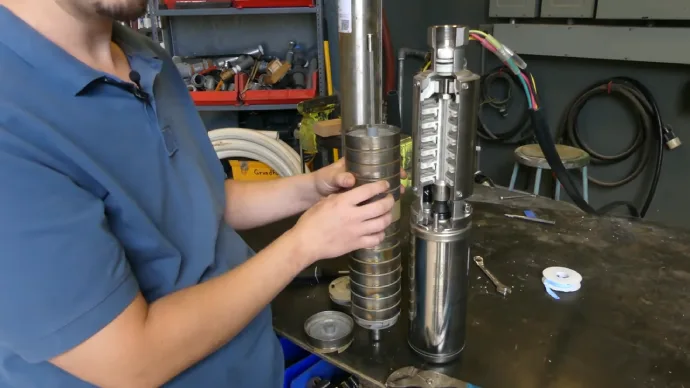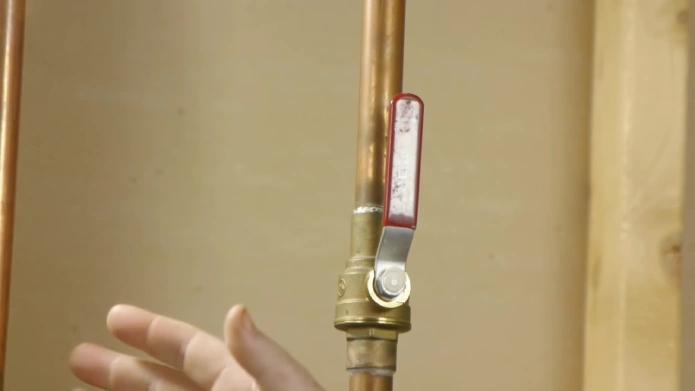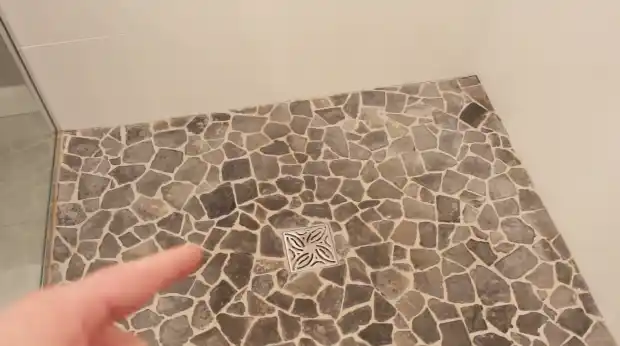Last Updated on July 13, 2023
Submersible well pumps are designed to withstand harsh environments, but that doesn’t mean they’re indestructible. Even though your pump is hidden beneath the surface of the earth, it’s working tirelessly to ensure you have a steady water supply.
Overheating can occur for various reasons, from an electrical issue to a lack of proper maintenance. But one of the reasons for overheating is the buildup of ochre or scale, which can hinder water flow and limit the motor’s cooling ability.
If left unchecked, overheating can lead to severe problems, including damage to the pump and potentially even a fire hazard. Today, we’ll explore the causes of submersible well pump overheating and how to identify it. So keep reading for more information.
What Causes to a Submersible Well Pump Overheat: Possible Reasons with Solutions

If your submersible well pump is overheating, there could be several reasons behind it.
- Improper Installation:
- Lack of Maintenance:
- Incorrect Oil/Lubricant:
- Worn-Out Parts:
- Clogged Filters:
- Operating Beyond Design Limits:
- Fluctuating Water Levels:
- Electrical Voltage Issues:
- Blocked or Damaged Cooling System:
- Inadequate Ventilation:
1. Improper Installation:
To prevent your submersible well pump from overheating, make sure you properly install it with aligned discharge pipes, adequate spacing, and proper placement for optimal airflow.
Here are four things to keep in mind when installing your submersible well pump:
- Align discharge pipes properly: The discharge pipe should be aligned with the pump to ensure that water flows out smoothly. Misaligned discharge pipes can cause blockages, leading to overheating.
- Provide adequate spacing: Make sure there’s enough space around the pump for proper ventilation. Lack of sufficient space can impede airflow, leading to heat buildup and overheating.
- Install at the proper depth: Submersible well pumps are designed to be installed at specific depths. Installing the pump at the wrong depth can cause it to work harder than necessary, leading to overheating.
- Choose the right location: The location of the pump is crucial. It should be installed in an area that’s protected from the elements and free from any obstructions that may impede airflow.
2. Lack of Maintenance:
Neglecting regular maintenance tasks like cleaning and lubrication can lead to a buildup of dust, debris, and mineral deposits that hinder heat dissipation and increase operating temperatures, creating a risky scenario for the pump’s longevity.
Over time, the accumulated debris can cause the pump to overheat and reduce its efficiency, resulting in higher energy bills and a shorter lifespan. Below is a table showing the potential consequences of neglecting pump maintenance:
| Neglected Maintenance Task | Consequences |
| Lack of cleaning | Buildup of debris, hindering heat dissipation and causing overheating |
| Lack of lubrication | Increased friction, leading to higher temperatures and reduced efficiency |
| Lack of inspection | Failure to detect and address issues such as leaks, clogs, and worn out parts |
3. Incorrect Oil/Lubricant:
Using the wrong type of oil or lubricant can cause damage to your machine and lead to decreased efficiency. Following the manufacturer’s guidelines for the appropriate lubricants to use in your submersible well pump is essential.
If you use the wrong oil, it can create excess friction within the pump, leading to increased heat generation. The heat can cause damage to internal components, leading to decreased efficiency and even complete failure.
4. Worn-Out Parts:
As you continue to operate your submersible well pump, the wear and tear on its components can cause them to break down and lose their effectiveness.
Bearings, seals, and impellers can become worn out, resulting in increased friction and heat that can cause the pump to overheat. This can decrease its overall lifespan and lead to costly repairs or replacement.
To prevent worn-out parts from causing issues with your submersible well pump, inspecting and maintaining its components regularly is important. This includes checking and replacing any damaged or worn parts, as well as ensuring proper lubrication to reduce friction and heat.
5. Clogged Filters:
Don’t let dirty filters ruin your pool party vibes, keep them cleaned or replaced regularly to ensure proper water flow and cooling for your submersible well pump. Clogged filters restrict water intake, leading to reduced cooling and increased pump temperatures, which can cause the pump to overheat.
Here are five things to consider about clogged filters and how they can affect your pump’s performance:
- Dirty or clogged filters can cause your submersible well pump to work harder to push water through, increasing energy costs.
- Overworked pumps can wear out faster, leading to costly repairs or replacements.
- Reduced water flow can cause air pockets in the pump, damaging the impeller or motor.
- Poor water circulation can also lead to algae growth, clogging filters even further and causing damage to the pump.
- Regular cleaning or replacement of filters is essential to ensure proper water intake and prevent overheating, which can cause permanent pump damage and costly repairs.
6. Operating Beyond Design Limits:
Now that you understand how clogged filters can cause a submersible well pump to overheat, let’s discuss another way this can happen. If you operate your pump beyond its design limits, you can cause the motor to work longer and produce more heat than it was designed to handle.
This can happen if you exceed the recommended flow rates or operate at excessive pressure. To better understand this concept, let’s take a look at the following table:
| Pump Design Limits | Operating Beyond Limits |
| Maximum Flow Rate | Exceeding this limit causes the motor to work harder and generate more heat. |
| Maximum Pressure | Operating at excessive pressures can also cause the motor to work harder and overheat. |
7. Fluctuating Water Levels:
Fluctuating water levels can wreak havoc on a pump by causing air pockets to form, potentially resulting in decreased performance and increased heat. When the water level fluctuates near the pump’s intake, the pump may start to operate ‘on the snore,’ drawing air into the system.
This can cause the pump to lose prime and result in overheating. As the air pockets move through the pump, they can create a cavitation effect, causing bubbles to collapse and generate high temperatures. This can damage the pump’s impeller and other components, reducing its efficiency and lifespan.
If you suspect that your submersible well pump is overheating due to fluctuating water levels, promptly addressing the issue is essential. You may need to adjust the pump’s location or install a device to regulate the water level near the intake.
8. Electrical Voltage Issues:
Voltage spikes, imbalances, or inadequate power supply can lead to overheating within the pump, which can cause serious damage to the unit and even pose a safety risk.
Surge protectors can help regulate voltage spikes and protect the pump from damage caused by electrical surges. Use surge protectors to avoid potential electrical issues and consult a licensed electrician when necessary.
A licensed electrician can diagnose and address any voltage-related issues, ensuring that your pump receives the appropriate power level and functions safely.
9. Blocked or Damaged Cooling System:
Regularly maintaining and cleaning the cooling system ensures the submersible well pump stays cool and optimizes. A clogged or damaged cooling system can put the pump at risk of overheating, similar to a car with a blocked radiator.
When the heat sinks are damaged or the vents are obstructed, the heat generated by the pump cannot dissipate effectively. As a result, the pump’s temperature rises and can cause damage to its internal components, such as the motor or wires.
To prevent the pump from overheating, perform regular inspections and clean the cooling system. This involves removing any debris, dirt, or contaminants that may have accumulated on the heat sinks or vents.
10. Inadequate Ventilation:
Submersible well pumps are designed to operate underwater, which can make it difficult to provide enough airflow around the motor. However, it’s important to ensure that the pump is installed correctly and has enough space around it to dissipate heat.
Any obstacles or obstructions around the pump can impede the airflow and cause the pump to overheat. Inadequate ventilation can also cause the pump motor to work harder, increasing wear and tear. This can reduce the pump’s lifespan and increase the risk of failure.
Follow the manufacturer’s recommendations for proper installation and spacing to avoid these issues. Also, regular maintenance and cleaning can ensure that the pump operates optimally and prevent any debris buildup or other obstructions that could impede airflow.
How do I know that the submersible well pump is overheating?

You can identify an overheating submersible well pump by observing a sudden loss of water pressure, hot water coming out of the faucets, and strange noises coming from the pump.
A Sudden Decrease in Water Pressure
When your submersible well pump suddenly experiences a drop in water pressure, it could be a sign of overheating and potential damage. Overheating can cause the motor to slow down, decreasing water pressure.
Here are some possible scenarios that could be happening:
- The motor is running too hot: If the motor’s temperature is too high, it can cause the pump to lose efficiency and struggle to maintain water pressure. This can happen if the pump runs for too long without a break or if the motor needs to be properly cooled.
- There’s a clog in the system: Overheating can also be caused by a clog in the well or the system. As the water gets trapped behind the clog, the motor has to work harder to push it out, causing it to overheat.
- The pump is worn out: If it is old or has been used extensively, it may be worn out and unable to maintain proper water pressure. This can cause the motor to work harder than it should, leading to overheating.
- The pump is too small: If the pump isn’t the right size for your well or water usage, it may need help to maintain water pressure and overheat. Ensuring the pump is properly sized for your specific needs is important.
Hot Water Coming Out of the Faucets
As you turn on the faucet, hot water rushes out, causing you to jump back in surprise. You wonder why the water is so hot, especially since you have yet to use any hot water recently. Your submersible well pump may be overheating, leading to the hot water coming out of the faucets.
When a submersible well pump overheats, it can cause the water in your well to heat up. This can lead to hot water coming out of your faucets, even when you haven’t turned on the hot water.
Strange Noises Coming from the Pump
If you’ve noticed hot water from your faucets, you may have initially assumed that your submersible well pump was overheating. However, this may only sometimes be the case.
While submersible well pumps can overheat, hot water coming out of your faucets is often a result of other issues such as a faulty water heater or a malfunctioning mixing valve.
If you’re experiencing strange noises coming from your pump, this could be a sign that your submersible well pump is overheating. When a well pump overheats, it can cause the motor to make unusual sounds.
Pump is Running Hot to the Touch
You may have noticed that your pump is running hot to the touch, which can be a sign of a serious issue that needs to be addressed promptly. A submersible well pump can overheat for some reasons, including a lack of proper lubrication or an obstruction in the water flow.
One possible cause of an overheating submersible well pump is a lack of proper lubrication. This can result in increased friction and heat, which can cause damage to the pump’s internal components.
The Pump is Drawing More Power than Usual
When your electricity bill is higher than usual, it could indicate that your pump is drawing more power than it should. An increase in power consumption means the pump is working harder than it needs to, which can lead to overheating.
To prevent the pump from drawing more power than necessary, check the pressure switch settings and ensure they’re set to the appropriate levels. Also, ensure the system is properly sized for your well and water usage needs.
The Performance of the Pump is Going Down Over Time
As the performance of your pumping system gradually decreases, it may be time to consider scheduling a maintenance check with a professional. Over time, submersible well pumps can experience wear and tear, causing them to become less efficient and less effective in delivering water to your home or property.
Some signs that your pump’s performance is decreasing include reduced water pressure, longer wait times for hot water, and slower water delivery.
Pump is Tripping Circuit Breakers
If your circuit breaker keeps tripping, it could be a sign that something is causing too much power to be drawn from the pump. One possible cause could be an overheating submersible well pump. When a pump overheats, it can cause the circuit breaker to trip as a safety measure to prevent further damage to the system.
What happens when a submersible pump overheats?
When a submersible pump overheats, it can have serious consequences. The insulation materials in the motor are designed to withstand certain heat levels, but when the temperature exceeds those limits, the insulation will deteriorate. This can lead to a motor failure and a complete breakdown of the pump system.
The steam created inside the pump casing can also cause damage to the impeller, pump seals, and the plastic piping that connects the various parts of the pump. This can result in leaks and other issues that will require costly repairs.
Take preventative measures to avoid overheating in your submersible pump. One way to do this is by ensuring that the pump is properly sized for your needs and running at the appropriate speed. You should also ensure the pump is properly installed and maintained, with regular inspections and cleanings.
Will a Submersible Well Pump shut off if it overheats?

Submersible well pumps can overheat and can shut down due to excessive heat. However, they have a thermal overload protection mechanism that automatically shuts off the pump when the motor temperature rises above safe limits.
To help you understand better, here’s a table that shows the consequences of an overheated submersible well pump:
| Consequence | Explanation | Solution |
| No water | The pump shuts off and won’t turn on until it cools down. | Wait for the pump to cool down. |
| Shortened lifespan | Overheating can cause permanent damage to the motor. | Replace the pump or motor. |
| Increased energy consumption | The motor has to work harder to pump water, leading to higher electricity bills. | Schedule regular maintenance to ensure your pump is working optimally. |
| Reduced pump efficiency | The pump may need to deliver a different amount of water than before. | Check the pump’s flow rate and consider upgrading to a higher-capacity pump. |
| Risk of fire | Overheating can cause the insulation to melt and spark a fire. | Shut off the pump immediately and call a professional for emergency repairs. |
Is it bad for a submersible pump to overheat continuously?
Continuous overheating can harm your water machine, shortening its lifespan and potentially causing permanent damage to the motor. Submersible well pumps are designed to operate in water, which cools the motor and prevents overheating.
However, if the motor is continuously overheating, it could be a sign of a problem with the pump or the well. One cause of continuous overheating is a clogged or dirty pump. If the pump isn’t cleaned regularly, debris and sediment can accumulate, reducing the water flow and causing the motor to work harder.
Another cause of overheating is a malfunctioning control box or pressure switch. These components regulate the pump’s operation and can cause the motor to run continuously or start and stop frequently, leading to overheating.
Prevent Submersible Well Pump Overheating: Follow Proper Guidelines
Submersible well pumps can overheat due to various factors, including hot liquid pumping, ochre or scale buildup, improper installation and maintenance. To prevent pump overheating, follow the manufacturer’s installation, use, and maintenance guidelines.
Despite your precautions, your submersible well pump can still overheat. You can do everything right and still end up with a burnt-out pump. It’s like wearing a seatbelt while driving but still getting into an accident.
Ultimately, it’s up to fate whether or not your submersible well pump will overheat. But with proper care and attention, your submersible well pump can provide a reliable and efficient water supply for years.



